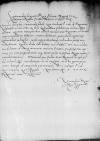Quae cf. [Ioannes DANTISCUS] & [Tiedemann GIESE] to [Sigismund I Jagiellon] Heilsberg (Lidzbark Warmiński), 1539-08-05, CIDTC IDL 7267⌊scribuntcf. [Ioannes DANTISCUS] & [Tiedemann GIESE] to [Sigismund I Jagiellon] Heilsberg (Lidzbark Warmiński), 1539-08-05, CIDTC IDL 7267⌋[1] Paternitates Vestrae de Hieronim Żelisławski (†1599), Polish nobleman⌊Hyeronimo ZelislawskiHieronim Żelisławski (†1599), Polish nobleman⌋, ea iam antea ex litteris Citizens of Gdańsk ⌊Gedanensium subditorum nostrorumCitizens of Gdańsk ⌋ cognoveramus. Quorum iustis precibus adducti mandavimus Hyeronimo, ut se coram certis consiliariis sisteret causam dicturus, quamobrem inimicitias Gedanensibus indixerit neque eas persecuturus, sed iudicio potius rem transacturus. Quod si diem sibi dictum non obiisset, tum vero mandata una dedimus ad omnes Royal Prussia (Prussia Regalis), region, part of Prussia annexed to the Kingdom of Poland in 1466 under the provisions of the Second Peace of Thorn⌊terrarum nostrarum PrussiaeRoyal Prussia (Prussia Regalis), region, part of Prussia annexed to the Kingdom of Poland in 1466 under the provisions of the Second Peace of Thorn⌋ praefectos sive capitaneos, ut eum prehenderent neque secus quam in hostem Poland (Kingdom of Poland, Polonia)⌊regni nostriPoland (Kingdom of Poland, Polonia)⌋ animadverterent.
cf. [Ioannes DANTISCUS] to Sigismund I Jagiellon Heilsberg (Lidzbark Warmiński), 1539-08-01, CIDTC IDL 3878⌊De iniuriiscf. [Ioannes DANTISCUS] to Sigismund I Jagiellon Heilsberg (Lidzbark Warmiński), 1539-08-01, CIDTC IDL 3878⌋, quae factae sunt reverendissimo in Christo patri Tiedemann Giese (Tidemannus Gisius) (*1480 – †1550), in 1519 ennobled by King Sigismund I; 1504-1538 Canon of Ermland (Warmia); 1516-1527, 1533-1537 Judicial Vicar and Vicar General of Ermland; 1523-1538 Custos of Ermland; 1537-1549 Bishop of Kulm (Chełmno); 1549-1550 Bishop of Ermland (BORAWSKA 1984, passim)⌊Culmensi episcopoTiedemann Giese (Tidemannus Gisius) (*1480 – †1550), in 1519 ennobled by King Sigismund I; 1504-1538 Canon of Ermland (Warmia); 1516-1527, 1533-1537 Judicial Vicar and Vicar General of Ermland; 1523-1538 Custos of Ermland; 1537-1549 Bishop of Kulm (Chełmno); 1549-1550 Bishop of Ermland (BORAWSKA 1984, passim)⌋, mandavimus, ut ei satisfiat neve hoc genus quaerimoniae deinceps ad aures nostras perveniant.
Bene valeant Paternitates Vestrae.


 BCz, 1601, p. 328
BCz, 1601, p. 328